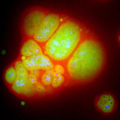
Active | Nucleolus subcompartments spontaneously self-assemble 13789The nucleolus is a small but very important protein complex located in the cell's nucleus. It forms on the chromosomes at the location where the genes for the RNAs are that make up the structure of the ribosome, the indispensable cellular machine that makes proteins from messenger RNAs.
However, how the nucleolus grows and maintains its structure has puzzled scientists for some time. It turns out that even though it looks like a simple liquid blob, it's rather well-organized, consisting of three distinct layers: the fibrillar center, where the RNA polymerase is active; the dense fibrillar component, which is enriched in the protein fibrillarin; and the granular component, which contains a protein called nucleophosmin. Researchers have now discovered that this multilayer structure of the nucleolus arises from difference in how the proteins in each compartment mix with water and with each other. These differences let them readily separate from each other into the three nucleolus compartments.
This video of nucleoli in the eggs of a commonly used lab animal, the frog Xenopus laevis, shows how each of the compartments (the granular component is shown in red, the fibrillarin in yellow-green, and the fibrillar center in blue) spontaneously fuse with each other on encounter without mixing with the other compartments. For more details on this research, see this press release from Princeton. Related to video 3791, image 3792 and image 3793. | | Public Note | | | | | Internal Note | | Researchers supplied video and gave permission for public use:
From: Nilesh Vaidya [nvaidya@princeton.edu]
To: Spiering, Martin (NIH/NIGMS) [C]
Cc: Clifford P. Brangwynne [cbrangwy@princeton.edu]
Thursday, May 26, 2016 10:33 AM
Dear Martin,
I am a co-first author of the article published on the journal Cell on how the nucleolus self-organizes. I was informed by my advisor Cliff Brangwynne that you are interested in including some of the images and videos of the nucleolus reported in our paper in your image gallery. I have attached few images (two for native and two for drug treated nucleoli) and couple of movies (fusion of nucleoli following drug treatment) with this email that are not published. For all images and movies, granular component (GC) is visualized with NPM1 (red), dense fibrillar component (DFC) with FIB1 (green), and fibrillar center (FC) with POLR1E (blue).
Please let me know if you have any questions. Thank you.
Best,
Nilesh Vaidya
Postdoctoral fellow
Brangwynne lab
Chemical and Biological Engineering
Princeton University
From: "Spiering, Martin (NIH/NIGMS) [C]"
Subject: Videos/images of nucleolus for NIGMS image gallery?
Date: May 23, 2016 at 12:37:21 PM EDT
To: "cbrangwy@princeton.edu"
Dear Dr. Brangwynne,
I am a writer and editor with the Office of Communication and Public Liaison at the National Institute of General Medical Sciences. I'm reaching out to you because we noticed your exciting new findings of how the nucleolus self-organizes, which were reported in a recent news release (athttp://www.princeton.edu/main/news/archive/S46/35/80M01/?section=topstories) highlighting your work. We're very interested in including some of your striking images and videos of the nucleolus reported in the paper into our image gallery (at https://images.nigms.nih.gov/) to bring your important work to broader public attention. | | | Keywords | | | | | Source | | Nilesh Vaidya, Princeton University | | | Date | | | | | Credit Line | | Nilesh Vaidya and Clifford Brangwynne, Princeton University | | | Investigator | | Clifford Brangwynne, Princeton University | | | Record Type | | Video | | | Topic Area(s) | | ;#Cells;#Chemistry, Biochemistry, and Pharmacology;#Genes;# | | | Previous Uses | | | | | Status | | Active | |
| | View All Properties | | Edit Properties |
|
